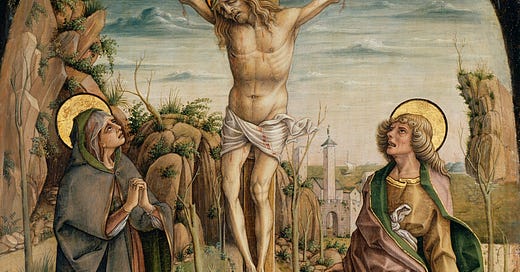Mysticism and music 5: Haydn's “The Seven Last Words of Christ” (free post)
Music for a Good Friday
The Oratorio de la Santa Cueva in Cádiz is, as its name suggests, an underground oratory — a “cave” church (you can read about it here). In 1786, Franz Joseph Haydn (1732 - 1809) was commissioned to compose, as Timothy Judd has described it (here), “a series of slow, meditative ‘sonatas,’ each relating to one of the seven last words of Christ during the crucifixion, as outlined in the Canonical Gospels of Matthew, Luke, and John.” Fifteen years later, Haydn himself described the project this way (again, I’m indebted to Judd’s short piece for the citation):
Some fifteen years ago I was requested by a canon of Cádiz to compose instrumental music on the Seven Last Words of Our Savior On the Cross. It was customary at the Cathedral of Cádiz to produce an oratorio every year during Lent, the effect of the performance being not a little enhanced by the following circumstances. The walls, windows, and pillars of the church were hung with black cloth, and only one large lamp hanging from the center of the roof broke the solemn darkness. At midday, the doors were closed and the ceremony began. After a short service the bishop ascended the pulpit, pronounced the first of the seven words (or sentences) and delivered a discourse thereon. This ended, he left the pulpit and fell to his knees before the altar. The interval was filled by music. The bishop then in like manner pronounced the second word, then the third, and so on, the orchestra following on the conclusion of each discourse. My composition was subject to these conditions, and it was no easy task to compose seven adagios lasting ten minutes each, and to succeed one another without fatiguing the listeners; indeed, I found it quite impossible to confine myself to the appointed limits…
There are four versions of Haydn’s Seven Last Words of Christ — the original orchestral work of 1786, a piano reduction of it, a 1787 version for string quartet (my favorite version), and finally the popular choral version in 1796. Regarding the last, Haydn discovered in Passau that a vocal arrangement of the work had been produced. It incorporated lyrics from Ramler’s “Der Tod Jesu,” and Haydn set himself to revise it.
Again, I cite Timothy Judd’s succinct but suggestive description of The Seven Last Words, since it can’t be bettered:
Haydn’s The Seven Last Words of Christ opens the door to a deep, contemplative drama. Monumental and seemingly timeless, the work defies the limits of a single genre. It cycles through a series of keys without establishing a “home,” giving us a sense of cosmic vastness. The musicologist Mark Spitzer observes that “the only other Classical ‘multi-piece’ which spreads itself across the entire tonal gamut with this architectural breadth is Beethoven’s String Quartet in C-sharp minor, op. 131.”
The facade of the Oratorio de la Santa Cueva, with its simple, Doric pilasters, provides little hint of the elaborate underground chapel which lies beyond. Haydn’s music begins with a similar musical facade, in the form of an introduction, set in the dark and ominous key of D minor. From the snarling opening bars, we are plunged into a ferocious and terrifying world. The trembling music which follows suggests haunting mystery, alienation, and lament. It’s filled with sudden, jagged edges. At moments, a few lingering strands are heard as a chilling whisper.
The seven Sonatas take us deep into a meditative space, akin to the chapel’s somber underground cave. (Haydn never visited Cádiz). As the music unfolds, wrenching anguish and lament combine with a sense of serene majesty and transcendence. We hear a tender and reverent conversation between instrumental voices. At moments, the music becomes strange and dissonant in a way which anticipates Beethoven’s Late String Quartets. The final movement’s thundering “earthquake” pulls us out of the meditative, spiritual realm and returns us to the physical world.
Below, I have provided links for three of the versions (not including the piano reduction), and a 2019 lecture on the work by Michael Parloff for the Lincoln Center Chamber Music Society.
First, here is the incomparable Jordi Savall, conducting the orchestral version in the Oratorio de la Santa Cueva in Cádiz, Spain — the original venue for Haydn’s work. It’s a beautiful video, rich with Spanish Catholic imagery:
*Click here to view it — this one can only be viewed directly on YouTube, and it’s worth it.*
The string version, here performed in darkness in 2018 by the Chiara String Quartet at the West Side Presbyterian Church in Ridgewood, NJ, is suitably atmospheric:
Lastly, here is the choral version (the lyrics with translation can be read here):
And, as an appendix, here is the lecture given by Michael Parloff, if you want to dig deeper:





I am always looking for genuinely great music; thank you so much!
On an unrelated note, do you think you could do a post on contemplative approaches for disconnecting from the "dopamine spiral" of the modern Internet/cell phone age? This would be especially pertinent for folks in my generation, as being really human is made exponentially more difficult by our effective slavery to the virtual world—our forefathers lived in a parody of true Reality, but we live in an empty parody of the parody!
How I love Haydn. Thank you for the reminder of this beautiful piece, and Savall's recording of it is indeed gorgeous!